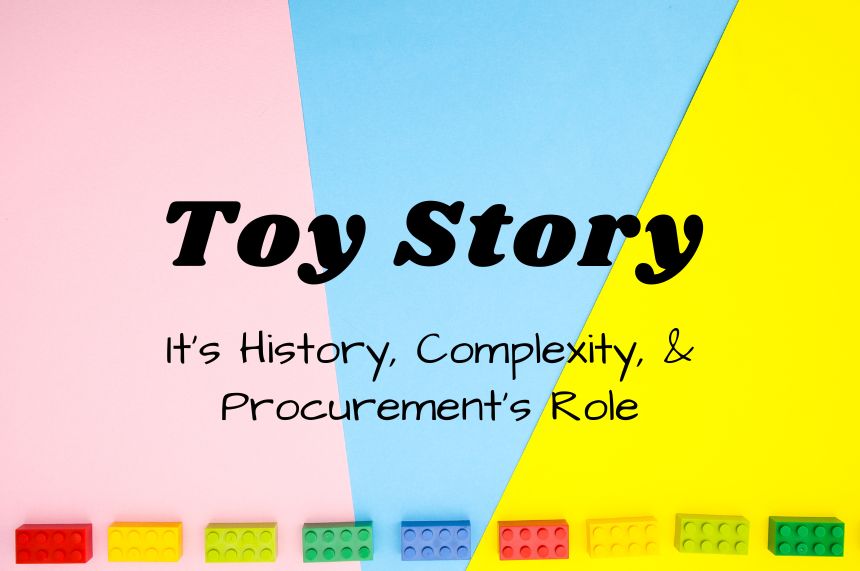Toy Story: It's History, Complexity & Procurement's Role
Business | December 28, 2022 | By
Remember the days when life was easy, devoid of social conventions and expectations, and unaffected by the challenging realities of adulthood? Remember your neighborhood was everything to you and toys were your only companion? You were a legend if you possessed a stuffed superhero, or the chosen one if you built your own toy house. You could imagine your entire life being written down on a magical slate and you could let your creativity run free while constructing Lego castles. Toys are simple, yet one of the most cherished symbols of childhood that aid in the physical, emotional, social, and cognitive development of children. But the toy industry comes with a very complex backstory.
Evolution of the Toy Industry
Toys are as old as civilization. The first known use of toys was in the 14th century. Many toys have been unearthed from several civilizations around the world and are known to be made with materials people could get their hands on – wood, clay, rocks, sticks, etc.

Egyptian toys were mostly made out of wood, stone, and pottery. Dolls were mostly made out of wood and balls were made out of marble. In ancient China, kites were made out of bamboo, and silk was used as early as 1000 B.C. Yo-Yos were made from wood, and wax dolls were used in ancient Greece in 500 B.C. In India, during the Indus Valley Civilization, toys included small carts, whistles shaped like birds, and toy monkeys that could slide down a string. And almost every part of the world has a rich legacy of toy making.
Impact of the Industrial Revolution
The modern toy industry began in the 18th century, thanks to the industrial revolution. And it was during this time that adults started seeing toys as more than just fun and games. Toys were considered as tools to stimulate learning.
The first jigsaw puzzle that was invented by John Spilsbury in 1767 was later used to help children learn geography. And around the same time, rocking horses inspired by rocking dragons came into the picture. They were initially conceived as tools to help children from an affluent English family learn horse riding skills but were soon adapted the world over.

In 1817, David Brewster invented the Kaleidoscope to help children understand geometric shapes and forms. And in the late 19th century, many public parks sprouted for recreation. This helped children mingle with people outside their families and develop social skills. The 19th century was also the period when there were many iconic toys. Remember Yo-Yos, Mecanna toys, Crayola Crayons, Raggedy Ann Doll, and Teddy Bear?
Toys and warfare

During the Second World War, the sale of war toys reached its peak. And as the war progressed, the industry faced a shortage of materials, so many toy factories had to be converted into arms factories. So there was a general decline in toy sales. Also, by the time the war ended, there was a decreased interest in war toys, a symptom of the waning disenchantment of the war.
Post the World Wars

The Second World War paved the way for many scientific and technological advancements. What was initially used only for warfare became available to the public later. And this new wave of innovative technologies brought in synthetic plastics and thus started the next era of children’s toys. Many new toys came into the picture and board games became a popular phenomenon – Chutes and Ladders, Candy Land, etc. In the 1950s, as birth rates increased more and more children’s toys came on the market. Frisbee, Hula-Hoops, Mr. Potato Head, and Barbie doll to name a few.
Going digital
Computers and computer technology (microprocessors and programming languages) in the 1970s opened the doors to a brand-new era of toys. Among the most popular items were Nerf Indoor Football, Paddington Bear, and the Baby Alive Doll. And thereafter almost every toy launched in the market had some kind of electronics in it. This was the era when educational toys also picked up. Toys such as Speak & Spell, a toy that helped children learn over 200 misspelled words using a speech synthesizer became so famous that they are now considered legends.

Next, video games became even more popular with the shift from the basic Atari to the Nintendo Game Boy. And as technology progressed with advanced networks, microprocessors, etc., toys became even more specialized. For example, advanced gaming consoles could connect to the internet.
Old is gold

And despite technological advances in toy manufacturing, there are still some toys that are manufactured without factories. Known as traditional or folk toys, they are typically made using traditional techniques and materials and are typically found in developing countries. Examples of traditional toys include woven dolls, clay figurines, and wooden toys. These toys are often made by artisans and sold on local markets, and they often have a distinctive cultural significance.
Role of Procurement in Toy Manufacturing
The role of procurement evolved in tandem with the toy industry. In ancient times, all toys were handmade from available materials. In fact, it was believed that the artisans themselves handpicked materials. And the role of procurement – though there wasn’t any role as such – was the same then too. Find the right material, at the right time and cost.
During the industrial revolution, because the industrial set-up was already available for various other products, toy manufacturers could learn from them and come up with novel solutions suited to mass-producing their toys. As a result, materials have to be selected, procured, and tracked. The role of procurement became more prominent in this era and gained departmental status too. The situation changed dramatically during the wars.
And during the two world wars, the role of procurement was mainly clerical. Order placement and tracking occupied a significant portion of procurement because supplies were scarce during the war. The goal throughout the war and the depression were to provide enough commodities, services, and raw resources to keep the economy running.
It was not until the late 1960s that procurement regained managerial status. As microprocessors and electronic chips entered the materials mix, procurement was responsible for sourcing them as well. And today, especially after the pandemic hit and seeing how procurement played a huge role, companies started involving CPOs in boardroom-level discussions. Procurement and supply chain teams are seen as key instruments to the success of organizations. This applies to more than just the toy industry.
Procurement software: The perfect gift for sourcing & procurement
In the past, toy producers frequently purchased raw materials and component parts from many vendors, then put them together in their own factories. However, as the toy industry became more globalized, businesses started to outsource different parts of the manufacturing process to foreign nations. As a result, intricate supply chains involving numerous businesses and nations came into the picture. The COVID-19 pandemic and other supply chain disruptions highlighted the vulnerabilities of these complex supply chains and exposed the need for a more resilient and agile procurement process. And in order to mitigate the risks associated with supply chain disruptions, toy manufacturers have had to adapt their procurement strategies and adopt new technologies. For example, modern procurement solutions that allow manufacturers to better track and manage their supply chains. This ensures that they are able to meet the demands of their customers even in the face of unforeseen challenges.
Today, with sustainability, supplier diversity, and other issues in the mix, it is imperative for procurement professionals not to spend their valuable time handling mundane tasks that can otherwise be done using the software. So that they can spend time on critical decision-making, managing supplier relationships, and ensuring on-time GTM.
So next time when you are in a retail store purchasing toys, think of their rich and complex history and how procurement plays a key role in making your loved ones’ lives happier. This holiday season, why not gift sourcing and procurement with the right procurement software? And if you are looking for one reach out to us at [email protected], or schedule a free demo to know more.
















